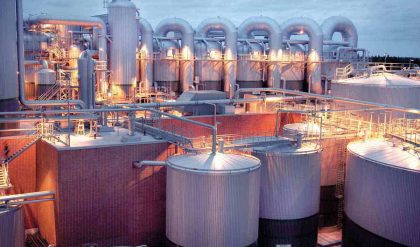The van der Waals equation was proposed in the year 1873. It was a first step towards taking into account interaction forces which are acting between real gases molecules.
The equation of state of the perfect gas refers to a gas consisting of point like items which do not interact with one another.
Instead of this van der Waals proposed an equation
(1)

where a and b are the so-called van der Waals constants and which have different values for each gas.
The b correction takes into account the fact that, according to van der Waals. the real gas molecules can move not in the total volume occupied by the gas, but only in a part of this volume which is defined by subtracting what he called the molecules own volume. The correction a/ν2 —proportional to the square of density-takes into account the attraction forces existing between gas molecules. According to the van der Waals assumption, these forces decrease the pressure against the vessel walls, because the molecules which are close to the wall are subjected to attraction of other molecules.
The a and b constants are to be considered as empirical; they have to be derived from experimental data on the density, temperature and pressure interdependence. For a number of technically important gases the van der Waals constants are tabulated.
According to the method of allowing for deviation of a real gas from a perfect gas, the van der Waals equation supposedly would be valid only for small deviations, i.e., for moderate pressures. But it turned out that this equation qualitatively satisfactorily describes the real gases behavior in a wide range of parameters including the critical region.
The van der Waals equation is a cubic one with respect to the specific volume. This means that in general at a given temperature, each pressure value corresponds to three specific volume values—ν1, ν, ν2. The values ν1 and ν2 correspond to physically existing states of liquid and vapor. The value ν, where (∂p/∂v)T > 0, corresponds to an unstable state and does not exist physically. As the temperature increases, the values ν1 and ν2 get closer and finally at the critical point all three roots coincide at the critical volume νc. At higher temperatures only one root of the van der Waals equation remains real, the two other being imaginary. These supercritical isotherms reveal inflexions at ν = νc which is close to the behavior of real substances.
As far as at the critical point, the following conditions are valid:

and it is possible, using the van der Waals equation, to derive interconnections between the van der Waals constants and critical parameters of a substance.

Hence the critical compressibility factor Zc will be identical for all substances and equal to

In reality the critical compressibility factors for the most substances fit into range 0.21-0.31.
The van der Waals equation can be rearranged to a nondimensional form using the reduced parameters:

In this coordinates the van der Waals equation becomes:
(2)

This means that, with reduced parameters, all substances obeying the van der Waals equation are described by an identical equation of state. From here it follows that all these substances can be treated similarly. For instance, at identical π and τ all substances have the same φ values. This generalized approach is used also with more sophisticated equations of state which describe the real substances behavior better than the van der Waals equation.


Comments are closed.